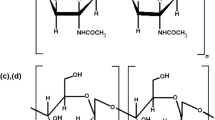Abstract
Unlike carrageenans, agars have not been studied very extensively by infrared spectroscopy, in so far as the structures of this kind of polygalactanes are not as well defined as carrageenans. However, in a previous work we have carried out a vibrational analysis of both carrageenans and agars and some important assignments of the main absorptions have been made. Consequently, the present work has been undertaken in order to identify agars without any extraction directly in various seaweeds using the infrared microspectrometry method. The main advantage of this method is that the sample consists only of a dehydrated algal section. The red algaeGradlaria verrucosa has been the subject of the present study. In the first place, spectra of extracted agars were recorded, as they can help us to confirm the nature of the compound identified by this technique. In a second stage, spectra of different parts of the sections have been carried out. The comparison between the resulting spectra with those of the extracted polysaccharides, has demonstrated, firstly that the best results are obtained from the cortical area, because, as expected, the agar is mainly located in the cell wall of this area of the algae. Indeed, the feature bands of agars are all observed, especially the intense ones between 1000 and 1100 cm−1 and the more characteristic absorptions in the wavenumbers range below 1000 cm−1 so as the ones at 988, 965, 930, 890, 870, 771 and 741 cm−1. Secondly, it may be also identified in smaller amounts in the medullar area, the cells are greater than in the cortical area and the cytoplasm is preponderent. However, in the latter case a coexisting polysaccharide, present in a considerable quantity and called floridean starch (Its structure is not very well known, as it varies from one algae to another), masks the spectra of agar, as its spectrum is very similar to those of polygalactanes.
Similar content being viewed by others
References
C. Araki,Proc. 4th Int. Biochem. Congr. 1958,1, 1.
R. Armisen, F. Galatas,FAO Technical Paper 1987,288, 1.
S. Arnott, A. Fullmer, W. E. Scott, J. C. M. Dea, R. Moorhouse, D. A. Rees,J. Mol. Biol. 1974,90, 268.
D. A. Rees,Adv. Carbohydr. Biochem. 1969,24, 267.
T. Stadler, D. Christiaen, M. C. Verdus, H. Morvan,Sciences de l'eau 1987,6, 105.
D. Christiaen, M. Lahaye, W. Yaphe,Northeast Algal Symposium, Woodshole, USA, 1985.
A. Mouradi-Givernaud, T. Givernaud, H. Morvan, J. Cosson,Bot. Mar. 1992,35, 153.
J. S. Graigie, C. Leigh, in:Handbook of Phycological Methods (J. A. Hellebust, J. S. Graigie, eds.), Cambridge University Press, 1978, pp. 60 and 143.
M. C. Verdus, D. Christiaen, T. Stadler, H. Morvan,Can. J. Bot. 1986,64, 96.
M. Dubois, K. A. Gilles, J. K. Hamilton, P. A. Rebers, F. Smith,Anal. Chem. 1956,28, 350.
W. Yaphe, G. P. Arsenault,Anal. Biochem. 1965,13, 143.
F. M. Maas, I. Hoffmann, M. I. van Harmelen, L. J. de Kok,Plant Soil 1986,91, 129.
J. H. Slonecker,Meth. Carbohydr. Res. Chem. 1972,6, 20.
M. Sekkal, P. Legrand,Spectrochim. Acta 1993,49A, 209.
D. Christiaen, M. Bodard,Bot. Mar. 1983,26, 425.
M. Sekkal,Doctoral Thesis, Lille I University, France, 1990.
P. D. Vasko, J. Blackwell, J. L. Koenig,Carbohydr. Res. 1972,23, 407.
J. J. Cael, J. L. Koenig, J. Blackwell,Carbohydr. Res. 1974,32, 79.
T. W. Barrett,Spectrochim. Acta 1981,37A, 233.
M. Sekkal, G. Vergoten, M. Dauchez, P. Legrand,Spectrochim Acta 1992,48A, 4.
D. Christiaen, H. Morvan, M. C. Verdus, T. Stadler,Intl. Workshop on Plant Polysaccharides, Struct, and Funct. Vol. 92, 1984, p. 196.
D. J. Standoff, R. H. Stanley,Int. Seaweed Symp. 1969,6, 596.
C. Y. Liang, R. H. Marchessault,J. Polym. Sci. 1959,37, 385.
R. H. Marchessault, C. Y. Liang,J. Polym. Sci. 1962,59, 357.
C. Rochas, M. Lahaye, W. Yaphe,Bot. Mar. 1986,29, 335.
T. Malfait, H. Vandael, H. Vancauwelaert,Int. J. Biol. Macromol. 1989,11, 259.
F. Bellanger, M. C. Verdus, V. Henocq, D. Christiaen,Hydrobiologia 1990,204–205, 527.
Author information
Authors and Affiliations
Rights and permissions
About this article
Cite this article
Sekkal, M., Huvenne, JP., Legrand, P. et al. Direct structural identification of polysaccharides from red algae by FTIR microspectrometry I: Localization of agar inGracilaria verrucosa sections. Mikrochim Acta 112, 1–10 (1993). https://doi.org/10.1007/BF01243315
Received:
Issue Date:
DOI: https://doi.org/10.1007/BF01243315




